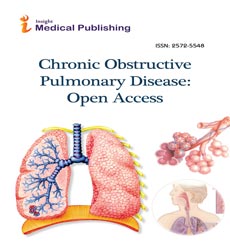Abstract
The Association between Chronic Obstructive Pulmonary Disease (COPD) and Atrial Fibrillation: A Review
COPD is one of the leading causes of Mortality & Morbidity in the US and is associated with a wide variety of cardiovascular diseases especially arrhythmias, angina, myocardial infarction and congestive heart failure and is directly associated with the severity of COPD described in the GOLD initiative. COPD is an independent risk factor for AF/AFL. Smoking, hypoxia and inflammation all contribute to AF in COPD patients mainly via atrial remodeling while hypercapnia contributes to it via increasing refractoriness of the atrial musculature and a delay in the return of the refractoriness to normal after resolution of the hypercapnia. The most common EKG abnormality found in patients with COPD is P pulmonale and the PQ interval is the strongest predictor of developing AF. The P wave Dispersion (PwD) was also an independent risk factor for the development of AF and was found to be more in the acute phase than in the stable phase.
The BODE index, an important prognostic score among patients hospitalized with a COPD exacerbation has a direct co relation with the prevalence of AF/AFL while the DECAF score, which was found to be superior to the CURB 65 score as a mortality predictor for hospitalized patients, includes AF as one of the criteria. Chronic hypoxemia is one of the main reasons for altered pulmonary vein anatomy and hence the presence of COPD was identified as an independent risk factor for the recurrence of atrial tachyarrhythmias after catheter ablation in patients with COPD and the absence of COPD was also found to be an independent predictor for a successful electro-cardioversion. These patients were also found to have an increased incidence of non-PV foci for the arrhythmias. Oral glucocorticoids were associated with an increased risk of developing AF especially high dose steroids. It is recommended to correct the underlying respiratory decompensation while treating patients with AF as they render the treatment of AF ineffective. Non-dihydropyridine calcium channel blockers should be used as first line rate control agents for AF in patients with concomitant COPD while the β-blockers, sotalol, propafenone can be used in patients with obstructive lung disease who do not have bronchospasm.
Author(s):
Varun Shah, Trishla Desai and Abhinav Agrawal
Abstract | Full-Text | PDF
Share this

Google scholar citation report
Citations : 130
Abstracted/Indexed in
- Google Scholar
- China National Knowledge Infrastructure (CNKI)
- Publons
- Geneva Foundation for Medical Education and Research
- Secret Search Engine Labs
Open Access Journals
- Aquaculture & Veterinary Science
- Chemistry & Chemical Sciences
- Clinical Sciences
- Engineering
- General Science
- Genetics & Molecular Biology
- Health Care & Nursing
- Immunology & Microbiology
- Materials Science
- Mathematics & Physics
- Medical Sciences
- Neurology & Psychiatry
- Oncology & Cancer Science
- Pharmaceutical Sciences

